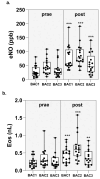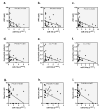The Late Asthmatic Reaction Is in Part Independent from the Early Asthmatic Reactions
- PMID: 40076712
- PMCID: PMC11900439
- DOI: 10.3390/ijms26052088
The Late Asthmatic Reaction Is in Part Independent from the Early Asthmatic Reactions
Abstract
House dust mites (HDM) are the world's most important cause of allergic asthma. It is unclear why some patients with HDM allergy develop an early asthmatic reaction (EAR) only, whereas others react with a dual asthmatic reaction-EAR plus late asthmatic reaction (LAR). In patients with LAR, the symptoms and bronchial inflammation are more severe, and the current knowledge suggests that the EAR always precedes the LAR. The aim of the present study was to investigate whether a LAR can occur separately even without a significant EAR. In a pilot study of 20 patients with asthma and HDM allergy, a bronchial allergen challenge (BAC) was performed on three separate occasions with a tapered allergen dose. Before and 24 h later, exhaled NO (eNO), eosinophils and miRNAs were measured as markers of bronchial inflammation. Compared to BAC1, at BAC2 there was a significant decrease in the EAR from mean 39.25 ± 13.37% to mean 33.55 ± 5.25% (p < 0.01), whereas the LAR remained unchanged: mean 28.10 ± 10.95% to mean 30.31 ± 7.77% (n.s.). At BAC3, both the EAR and the LAR were significantly attenuated compared to the first and second BAC. In 3 (15%) patients, even the tapered allergen dose induced a dual asthmatic reaction. In 10 (50%) patients, the allergen dose was too low to trigger a significant EAR and LAR. In 7 (35%) patients, there was no EAR, but a significant LAR (mean max fall FEV1 20.5 + 4.7%) recorded. Significant correlations (p < 0.05) were found between distinct miRNAs (miR-15a-5p, miR-15b-5p and miR-374a-p5), eNO, and the decline in lung function and the presence of a LAR (p < 0.01). We can demonstrate that a LAR is induced in some patients without an EAR to low allergen exposure. This leads to a strong inflammatory reaction with an increase in eNO and a decrease in FEV1 and distinct miRNAs. Accordingly, these individuals are at greater risk of asthmatic symptoms and remodeling with loss of lung function than patients who do not have a LAR.
Keywords: bronchial allergen challenge; early asthmatic and late asthmatic reaction; epigenetic regulation; house dust allergy; microRNAs.
Conflict of interest statement
Stefan Zielen received fees for lectures and advisory boards from the following companies: Engelhard-Arzneimittel GmbH; AstraZeneca; Sanofi Pasteur, Stallergen-Geer; Allergy Therapeutics and Boehringer Ingelheim. Authors Stefan Zielen, Oguzhan Alemdar, Andreas Wimmers were employed by the company Medaimun GmbH. The remaining authors declare that the research was conducted in the absence of any commercial or financial relationships that could be construed as a potential conflict of interest.
Figures




Similar articles
-
MicroRNA Profiling of the Inflammatory Response after Early and Late Asthmatic Reaction.Int J Mol Sci. 2024 Jan 22;25(2):1356. doi: 10.3390/ijms25021356. Int J Mol Sci. 2024. PMID: 38279356 Free PMC article.
-
Allergen-induced early and late asthmatic responses to inhaled seasonal and perennial allergens.Clin Exp Allergy. 2015 Nov;45(11):1647-53. doi: 10.1111/cea.12587. Clin Exp Allergy. 2015. PMID: 26115509
-
The allergen specificity of the late asthmatic reaction.Allergy. 2010 Mar;65(3):355-8. doi: 10.1111/j.1398-9995.2009.02184.x. Epub 2009 Oct 5. Allergy. 2010. PMID: 19804443 Clinical Trial.
-
Allergen-induced bronchial inflammation in house dust mite-allergic patients with or without asthma.Clin Exp Allergy. 2002 Dec;32(12):1720-7. doi: 10.1046/j.1365-2222.2002.01542.x. Clin Exp Allergy. 2002. PMID: 12653162
-
Bronchial asthma triggered by house dust mites in patients with local allergic rhinitis.Allergy. 2019 Aug;74(8):1502-1510. doi: 10.1111/all.13775. Epub 2019 Apr 15. Allergy. 2019. PMID: 30887534
References
MeSH terms
Substances
LinkOut - more resources
Full Text Sources
Medical
Miscellaneous

